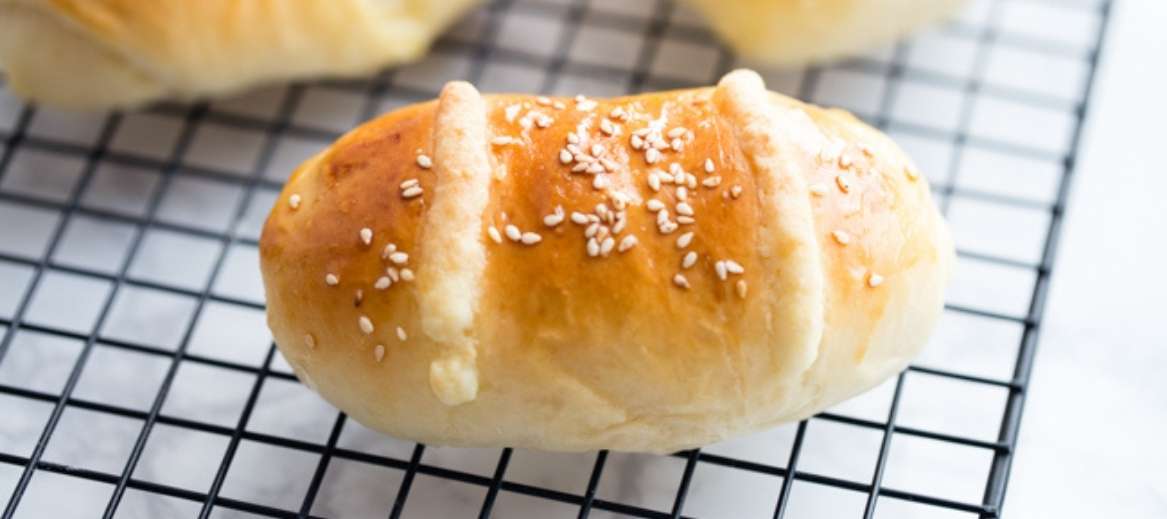COCONUT BUNS (CHINESE COCKTAIL BUNS)
Cocktail buns are on the blog today as part of the current Chinese bakery trend. They are also called chicken tail buns (or gai mei bao). Everyone on my father’s Cantonese side would always bring a Chinese bakery box full of pineapple buns, roast pig buns, hot dog buns, or just plain buttery milk bread to any huge family reunion we attended. Whether it was a kid or a parent, everyone would peek into the box and eat something before supper. The number of recipes we’ve attempted to reproduce in a flurry of flour, cream, and profanity shows just how much we adore these sweets.
Although we’ve previously cooked Inside-out coconut buns on this blog, that recipe was a little out of the ordinary. When making traditional cocktail buns, we now use our dependable milk bread recipe as a starting point.
I’m not a fan of how the filling is normally globbed together in the middle when it comes to coconut cocktail buns. To get more filling and bread into each mouthful, I scraped some of the fillings from the center and distributed them to the remainder of the bread while I ate it.
I have a better method now that I can run a mixer. Rolling the cocktail buns into a cigar ensures that the filling is evenly distributed throughout. So I’ve been planning this recipe since I was five years old.
This one’s for you, guys!
INGREDIENTS:
BREAD DOUGH
- 160 ml of heavy cream
- 1 large egg
- 3 1/2 cups of bread flour
- 1 cup of milk
- 1/3 cup of sugar
- 1/2 cup of cake flour
- 1 tablespoon of active dry yeast
- 1 1/2 teaspoons of salt
FILLING
- 85g of softened butter
- 3 tablespoons of cake flour
- 3 tablespoons of caster sugar
- ½ cup of desiccated coconut
- ¼ cup of dry milk powder
TOPPINGS
- 38g of cake flour
- 43g of softened butter
- 4 ½ teaspoons of caster sugar
- egg wash
- 1 tablespoon of toasted sesame seeds
- 1 tablespoon of sugar dissolved in 1 tablespoon hot water
INSTRUCTIONS:
- Make the bread dough first, ensuring all ingredients are at room temperature. Add the heavy cream, milk, egg, sugar, cake flour, bread flour, yeast, and salt to the bowl of a mixer (in that order). Start the mixer on the lowest setting and add the dough hook attachment.
- Allow it to run for 15 minutes, stopping the mixer now and then to knead the dough. (Note: Add additional flour, 1/4 cup at a time, until the dough comes together if you live in a humid region and the dough is too sticky.) The dough is ready for proving after 15 minutes. The bowl should be covered with a moist towel and left in a warm location for an hour. The dough will increase in size by almost 1.5 times.
- In the meantime, make the filling by thoroughly blending each of the ingredients in a bowl. Place aside.
- Put the dough back in the mixer and softly knead it for 5 minutes to remove air bubbles after the bread dough has proofed for an hour. Lay the dough out and divide it into 12 equal pieces. Lightly dust the board.
- With your hands, flatten each piece of dough into a rough oval shape that is 4 inches long and 3 inches broad. A tablespoon or so of filling should be spread in the center of the dough before rolling it like a cigar and tucking the ends under the bun to enclose the contents completely. This approach works well because it allows the filling to be distributed evenly throughout the bun.
- Place the buns on a baking sheet lined with parchment paper and cover with a fresh kitchen towel. Allow rising for a further 45 to 60 minutes.
- Set your oven’s temperature to 350. To make the topping, combine 1/3 cup cake flour, three tablespoons softened butter, and 4 12 teaspoons caster sugar. Transfer the mixture to a small zip-top or piping bag and cut a small corner off. Place aside.
- Apply egg wash once the buns have risen. Each bun should have two stripes of the topping mixture before being dusted with sesame seeds. Bake until golden, about 15 to 17 minutes. After baking, brush the dish with sugar syrup.
